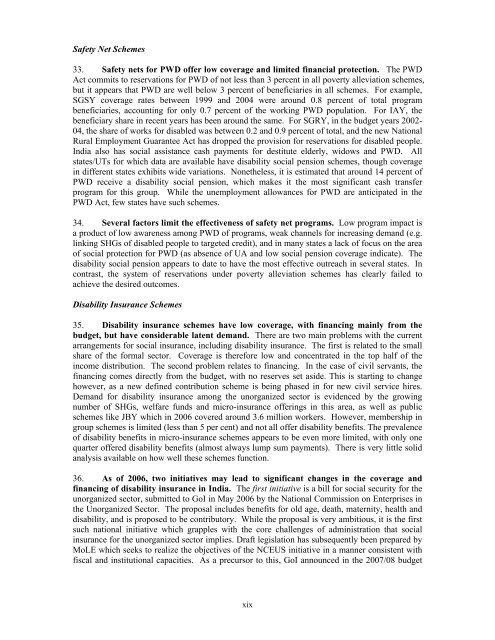People with Disabilities in India: From Commitment to Outcomes
People with Disabilities in India: From Commitment to Outcomes
People with Disabilities in India: From Commitment to Outcomes
You also want an ePaper? Increase the reach of your titles
YUMPU automatically turns print PDFs into web optimized ePapers that Google loves.
Safety Net Schemes<br />
33. Safety nets for PWD offer low coverage and limited f<strong>in</strong>ancial protection. The PWD<br />
Act commits <strong>to</strong> reservations for PWD of not less than 3 percent <strong>in</strong> all poverty alleviation schemes,<br />
but it appears that PWD are well below 3 percent of beneficiaries <strong>in</strong> all schemes. For example,<br />
SGSY coverage rates between 1999 and 2004 were around 0.8 percent of <strong>to</strong>tal program<br />
beneficiaries, account<strong>in</strong>g for only 0.7 percent of the work<strong>in</strong>g PWD population. For IAY, the<br />
beneficiary share <strong>in</strong> recent years has been around the same. For SGRY, <strong>in</strong> the budget years 2002-<br />
04, the share of works for disabled was between 0.2 and 0.9 percent of <strong>to</strong>tal, and the new National<br />
Rural Employment Guarantee Act has dropped the provision for reservations for disabled people.<br />
<strong>India</strong> also has social assistance cash payments for destitute elderly, widows and PWD. All<br />
states/UTs for which data are available have disability social pension schemes, though coverage<br />
<strong>in</strong> different states exhibits wide variations. Nonetheless, it is estimated that around 14 percent of<br />
PWD receive a disability social pension, which makes it the most significant cash transfer<br />
program for this group. While the unemployment allowances for PWD are anticipated <strong>in</strong> the<br />
PWD Act, few states have such schemes.<br />
34. Several fac<strong>to</strong>rs limit the effectiveness of safety net programs. Low program impact is<br />
a product of low awareness among PWD of programs, weak channels for <strong>in</strong>creas<strong>in</strong>g demand (e.g.<br />
l<strong>in</strong>k<strong>in</strong>g SHGs of disabled people <strong>to</strong> targeted credit), and <strong>in</strong> many states a lack of focus on the area<br />
of social protection for PWD (as absence of UA and low social pension coverage <strong>in</strong>dicate). The<br />
disability social pension appears <strong>to</strong> date <strong>to</strong> have the most effective outreach <strong>in</strong> several states. In<br />
contrast, the system of reservations under poverty alleviation schemes has clearly failed <strong>to</strong><br />
achieve the desired outcomes.<br />
Disability Insurance Schemes<br />
35. Disability <strong>in</strong>surance schemes have low coverage, <strong>with</strong> f<strong>in</strong>anc<strong>in</strong>g ma<strong>in</strong>ly from the<br />
budget, but have considerable latent demand. There are two ma<strong>in</strong> problems <strong>with</strong> the current<br />
arrangements for social <strong>in</strong>surance, <strong>in</strong>clud<strong>in</strong>g disability <strong>in</strong>surance. The first is related <strong>to</strong> the small<br />
share of the formal sec<strong>to</strong>r. Coverage is therefore low and concentrated <strong>in</strong> the <strong>to</strong>p half of the<br />
<strong>in</strong>come distribution. The second problem relates <strong>to</strong> f<strong>in</strong>anc<strong>in</strong>g. In the case of civil servants, the<br />
f<strong>in</strong>anc<strong>in</strong>g comes directly from the budget, <strong>with</strong> no reserves set aside. This is start<strong>in</strong>g <strong>to</strong> change<br />
however, as a new def<strong>in</strong>ed contribution scheme is be<strong>in</strong>g phased <strong>in</strong> for new civil service hires.<br />
Demand for disability <strong>in</strong>surance among the unorganized sec<strong>to</strong>r is evidenced by the grow<strong>in</strong>g<br />
number of SHGs, welfare funds and micro-<strong>in</strong>surance offer<strong>in</strong>gs <strong>in</strong> this area, as well as public<br />
schemes like JBY which <strong>in</strong> 2006 covered around 3.6 million workers. However, membership <strong>in</strong><br />
group schemes is limited (less than 5 per cent) and not all offer disability benefits. The prevalence<br />
of disability benefits <strong>in</strong> micro-<strong>in</strong>surance schemes appears <strong>to</strong> be even more limited, <strong>with</strong> only one<br />
quarter offered disability benefits (almost always lump sum payments). There is very little solid<br />
analysis available on how well these schemes function.<br />
36. As of 2006, two <strong>in</strong>itiatives may lead <strong>to</strong> significant changes <strong>in</strong> the coverage and<br />
f<strong>in</strong>anc<strong>in</strong>g of disability <strong>in</strong>surance <strong>in</strong> <strong>India</strong>. The first <strong>in</strong>itiative is a bill for social security for the<br />
unorganized sec<strong>to</strong>r, submitted <strong>to</strong> GoI <strong>in</strong> May 2006 by the National Commission on Enterprises <strong>in</strong><br />
the Unorganized Sec<strong>to</strong>r. The proposal <strong>in</strong>cludes benefits for old age, death, maternity, health and<br />
disability, and is proposed <strong>to</strong> be contribu<strong>to</strong>ry. While the proposal is very ambitious, it is the first<br />
such national <strong>in</strong>itiative which grapples <strong>with</strong> the core challenges of adm<strong>in</strong>istration that social<br />
<strong>in</strong>surance for the unorganized sec<strong>to</strong>r implies. Draft legislation has subsequently been prepared by<br />
MoLE which seeks <strong>to</strong> realize the objectives of the NCEUS <strong>in</strong>itiative <strong>in</strong> a manner consistent <strong>with</strong><br />
fiscal and <strong>in</strong>stitutional capacities. As a precursor <strong>to</strong> this, GoI announced <strong>in</strong> the 2007/08 budget<br />
xix










